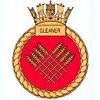HMS Gleaner (H86)
_in_the_Solent.jpg) HMSML Gleaner in the Solent, 2013 | |
| History | |
|---|---|
| Name: | Her Majesty's Survey Motor Launch 'Gleaner |
| Operator: | Royal Navy |
| Builder: | Emsworth |
| Launched: | 18 October 1983 |
| Sponsored by: | Mrs. M. Read |
| Commissioned: | 5 December 1983 |
| Decommissioned: | 16 February 2018 |
| Homeport: | HMNB Devonport, Plymouth |
| Identification: |
|
| Motto: |
|
| Status: | Awaiting disposal |
| Badge: |
 |
| General characteristics | |
| Displacement: | 22 tonnes |
| Length: | 14.8 m |
| Beam: | 4.7 m |
| Draught: | 1.6 m |
| Propulsion: | 2 × Volvo Penta TAMD 122 P-A diesel engines |
| Speed: | 14 knots (16.1 mph; 25.9 km/h) |
| Complement: | 9 |
| Crew: | 2 Officers, 1 Senior Rate, 6 Junior Rates |
| Notes: | Uses multibeam and sidescan sonar to collect accurate data about the texture of the seabed. Can be used in the shallowest of inshore waters. |
HMSML Gleaner (H86) was the smallest commissioned vessel in the Royal Navy, at the time of her decommissioning, with a length of just under 15 metres and a ship's company of just nine (two officers, one Senior Rating and six Junior Ratings). She was based in Devonport, Plymouth. The ship prefix "HMSML" stands for Her Majesty's Survey Motor Launch.[1]
According to a parliamentary written reply and Freedom of Information answer, Gleaner was to be withdrawn from service in 2018.[2][3] A replacement vessel, HMS Magpie, was commissioned in June 2018.[4]
History
Gleaner was the sixth ship to bear the name and was commissioned on 5 December 1983. With a top speed of 14 knots (26 km/h; 16 mph), Gleaner was designed to conduct inshore surveys along the south coast of England, though she has since surveyed all around the coastline of Great Britain and visited various ports in Europe.
As an advanced survey vessel, Gleaner possessed an array of sophisticated technology, including multibeam and sidescan sonar to collect bathymetry and seabed texture data and compile an accurate and detailed picture of the seabed for later analysis. Her survey equipment also included an Applanix POS MV system for georeferencing and motion compensation, C-NAV GPS, Kongsberg EM2040 Multibeam Echo Sounder and Kongsberg EA400 Singlebeam Echo Sounder.
Gleaner also has the unique distinction of being one of a handful of Royal Navy ships to have visited landlocked Switzerland, having travelled up the Rhine to Basle in 1988. Earlier visits were by HMS Flintham and Dittisham in 1969, and HMS Sabre and Cutlass in 1979.[5][6]
She was also in attendance at the 2010 Portsmouth Navy Days.[7][8]
In 2016, Gleaner conducted an extensive survey of the Firth of Forth as part of the preparation work for the departure of HMS Queen Elizabeth in the spring of 2017. This work was necessary as the most recent survey was 60 years old.[9]
Gleaner entered Plymouth for the last time on 31 January 2018 before being decommissioned,[10]. Gleaner will be replaced by HMS Magpie, which was commissioned in June 2018.[11]
References
- ↑ http://www.royalnavy.mod.uk/our-organisation/the-fighting-arms/surface-fleet/survey/coastal-survey-ship/hms-gleaner
- ↑ http://www.parliament.uk/business/publications/written-questions-answers-statements/written-question/Lords/2016-04-11/HL7484/
- ↑ https://www.gov.uk/government/uploads/system/uploads/attachment_data/file/525150/Navy_FOI2016_04694____HMS_Gleaner_to_be_withdrawn_in_2018.pdf
- ↑ "Royal Navy commissions new survey ship HMS Magpie".
- ↑ "Kingfisher not the highest". Navy News. February 1980. p. 7. Retrieved 31 July 2017.
- ↑ HMS Gleaner (archive), royalnavy.mod.uk
- ↑ New additions to Navy Days 2010, dalyhistory.wordpress.com, 10 June 2010
- ↑ Navy’s Smallest Vessel on View at Navy Days 2010!, historicdockyard.co.uk, 19 April 2010
- ↑ "Navy's smallest ship paves way for maiden voyage of its largest". Royal Navy. 2 September 2016. Retrieved 2 September 2016.
- ↑ "Little But Mighty: Farewell To The Navy's Smallest Ship". Forces News. 31 January 2018. Retrieved 31 January 2018.
- ↑ "New survey ship HMS Magpie on sea trials". Royal Navy. 24 April 2018. Retrieved 24 April 2018.
External links
- Royal Navy HMS Gleaner (royalnavy.mod.uk)
